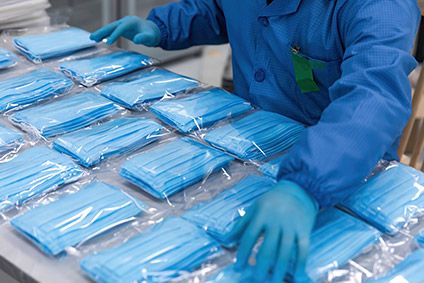
As many businesses globally are being given the green light by governments to reopen their doors following the coronavirus pandemic, the International Labour Organisation (ILO) has created a checklist to ensure the safe return of workers.
Return to work policies should be informed by a human-centred approach that puts rights and international labour standards at the heart of economic, social and environmental strategies and ensures that policy guidance is embedded in national occupational safety and health systems, says the ILO, which has released two guidance documents to aid businesses that are reopening.
The Guidance Note draws on specialist ILO guidance documents and International Labour Standards, which provide a normative framework for creating a safe return to work. The document stresses that policy guidance should be embedded into national Occupational Safety and Health (OSH) systems, as these create the basis for safe workplace environments. The guidance can, therefore, contribute to a culture of continuous, country-level improvement, in administration, institutions, laws and regulations, labour inspections, information gathering, and other areas.
Deborah Greenfield, ILO’s deputy director-general for policy, says workers must feel safe at their workplaces, both from risks directly related to Covid-19, and indirect risks, including psychosocial issues and ergonomic risks related to working in awkward positions or with poor facilities when working from home, the guidelines say. They should have the right to remove themselves from any situation “which they have reasonable justification to believe presents an imminent and serious danger to their life or health”, and “shall be protected from any undue consequences”.
The document proposes that each specific work setting, job or group of jobs should be assessed before returning to work and that preventive measures should be implemented to ensure the safety and health of all workers according to a hierarchy of controls. For workers staying at home, the risk of infection in a work context can be eliminated; for all workers returning to workplaces, priority should be given to options that substitute hazardous situations for less hazardous ones, such as organising virtual instead of physical meetings. When this is not possible a mix of engineering and organisational control measures will usually be required to prevent contagion. The specific measures to implement are specific to each workplace, but may consist of installing physical barriers such as clear plastic sneeze guards, improving ventilation, or adopting flexible working hours, in addition to cleaning and hygiene practices. The guidelines also recall that the use of appropriate personal protective equipment may be required to complement other measures, in particular for the most hazardous occupations, and that this equipment should be provided without cost to workers.
See Also:
The needs of workers at higher risk of severe illness should be taken into account; including older workers, pregnant workers, those with pre-existing medical conditions, refugees, migrants and those in the informal sector. Special attention will be needed to ensure that return to work policies do not create discrimination related to gender, health status, or other factors.
How well do you really know your competitors?
Access the most comprehensive Company Profiles on the market, powered by GlobalData. Save hours of research. Gain competitive edge.

Thank you!
Your download email will arrive shortly
Not ready to buy yet? Download a free sample
We are confident about the unique quality of our Company Profiles. However, we want you to make the most beneficial decision for your business, so we offer a free sample that you can download by submitting the below form
By GlobalData“Unsafe work practices anywhere are a threat to both health and sustainable business, everywhere. So, before returning to work, workers must be confident that they will not be exposed to undue risks,” says Greenfield. “And, to help enterprises and economies get going as soon as possible, workers will need to cooperate with these new measures. This means that social dialogue will be particularly important because it is the most effective way to feed information and views into policies and actions, so creating the best chance for a swift and balanced recovery.”
The ILO has also issued a ten-point action plan intended to provide guidance to employers, workers and their representatives on preventive measures for a safe return to work in the context of Covid-19.
1. Form a joint team to plan and organise return to work
- The business should convene its joint occupational safety and health committee. If there is no such committee, constitute a joint team with the same number of members representing the employer and workers.
- Train team members on the basic principles for the formulation and implementation of occupational safety and health preventive and control measures.
- Direct the team to develop a work plan that includes the steps to be taken to organize a safe and healthy return to work. Integrate this work plan into the business continuity plan.
- Effectively communicate to all workers in the company about the team and its work
2. Decide when to reopen, who returns and how
- Undertake a risk assessment to determine the preventive and control measures necessary for a safe return to work.
- Ensure that prevention and control measures are implemented before resuming business activity.
- Establish policies and procedures regarding the number of workers and visitors in the workplace.
- If possible, plan for reopening in phases from a minimum level to a normal level of operations. If a phased approach is taken, identify critical personnel who will need to be present at the workplaces during the reopening process. Identify focal points to monitor prevention and control measures.
3. Adopt engineering, organisational, and administrative measures
- Implement a hierarchy-of-controls strategy that prioritises engineering, organizational and administrative controls to prevent disease transmission.
- Avoid physical interaction. Promote, as far as possible, remote work and telework.
- Ensure physical distancing of at least 2 metres at all times and in all work-related situations.
- Install physical barriers or screens to ensure physical separation between workers who share a space in the workplace, as well as between workers and third parties such as customers, suppliers, and users.
- Determine and signal the maximum capacity of the workplace and its different areas (meeting rooms, offices, workshops, dining rooms, elevators, bathrooms, changing rooms and other common spaces) in order to ensure at least minimum physical distancing.
- Ventilate the workplace daily, preferably with natural ventilation by opening the windows. In case of work shifts, repeat the natural ventilation between each shift.
- In case of mechanical ventilation, maintain recirculation with outdoor air. Avoid the use of individual fans.
- Ensure proper maintenance/installation of heating, ventilation and air conditioning systems.
- Avoid concentration of workers: In case of use of collective transport, organise on a temporary basis, as far as possible, company-specific mobility options (such as buses chartered by the company) in which a minimum separation of 2 metres between persons is ensured.
- Provide staggered or flexible arrival and departure times to avoid the use of mass transport at peak hours and crowding at entrances and exits.
- Adopt work rotation measures, including alternating working days, to avoid large groups of workers.
- In case of work shifts, provide a gap between the arrival of one shift and the departure of another.
- Limit the capacity of common areas such as dining rooms, snack bars, and rest and changing rooms to allow the minimum separation of 2 metres.
- Organise one-way systems.
- During the restart of activities avoid external visits, and re-evaluate this measure continuously.
- Temporarily restrict meal preparation services, privileging packaged options.
- Provide workers with all necessary information about the process and measures taken before reopening the workplace, and after reopening.
- According to national law, inform staff of their right to remove themselves from any situation which they have reasonable justification to believe presents an imminent and serious danger to their life or health, and the need to immediately inform their direct supervisor.
- Arrange signage or other graphic material in visible places of the workplace with the preventive measures to be taken against Covid-19.
4. Regularly clean and disinfect
- Thoroughly clean and disinfect the premises before reopening.
- Prioritise the use of electrostatic spray surface cleaning and use chemicals approved by national authorities.
- Increase the frequency of cleaning and disinfection, in particular heavily-trafficked areas. Increase trash collection and keep machines and surfaces clean and disinfected.
- Increase cleaning and disinfection measures in common areas.
- Promote “I keep my workstation clean and tidy” commitment among workers and encourage frequent sanitation breaks.
- Discourage the sharing of items such as office supplies and tableware.
- Ensure cleaning and disinfection procedures for goods/supplies/mail/packages received.
- Make cleaning schedules and checks visible to all workers/clients.
- Implement procedures to communicate and address issues related to cleaning and disinfection of premises.
5. Promote personal hygiene
- Provide workers with the conditions and means necessary for frequent handwashing with soap and water for at least 40 seconds or with a disinfectant gel with a minimum of 60% alcohol (alcohol gel 60%) for at least 20 seconds. Prioritize the use of liquid soap dispensers instead of soap tablets. Install signage for proper handwashing.
- Install handwashing facilities or alcohol gel 60% at the entrance and across the workplace/premises. If possible, install alcohol-based hand sanitizer stations.
- Prioritize the use of paper towels instead of fabric towels or electric airjet drying devices.
- Inform workers of the need to avoid physical contact when greeting, and avoid touching eyes, nose and mouth without having previously performed hand hygiene and disinfection.
- Inform workers of the need to cover the mouth and nose with a disposable handkerchief when coughing or sneezing, or, if possible, with the inner face of the forearm/elbow, removing the handkerchief immediately and then washing the hands with soap and water or with an alcohol-based disinfectant.
- Inform workers to avoid sharing food, drinks, kitchen and personal toilet items.
- Restrict or reduce the use of cash by privileging other means of payment.
6. Provide PPE and inform workers of its correct use
- Identify appropriate PPE related to the tasks and health and safety risks faced by workers according to the results of risk assessment and the level of risk, and provide it to workers free of charge and in sufficient number, along with instructions, procedures, training and supervision.
- Maintain, clean, disinfect and store PPE according to instructions.
7. Health surveillance
- Monitor the health status of workers, develop protocols for cases of suspected and confirmed contagion, and provide for the protection of medical and private data, in accordance with national law and guidance.
- Define protocols to stay at home for workers with symptoms or confirmation of contagion.
- Identify workers who have had close contact with people infected with Covid-19 and direct them to follow the instructions of the medical service or their health care professional and health authorities.
- Communicate confirmed cases of Covid-19 infection to the appropriate authorities.
8. Consider other hazards, including psychosocial
- Regularly communicate to the workforce the changes made at the workplace due to Covid-19 and how the situation is evolving.
- Make psychological counselling services available to workers in case of need.
- Encourage health promotion and wellbeing in the workplace through enough rest, balance of physical and mental activity and adequate work-life balance.
- Promote the right to disconnect for remote workers and teleworkers.
- Provide information about ergonomic risks, particularly during remote work and in workstations adapted to Covid-19.
- Implement prevention and control measures for the use and storage of chemicals, particularly those used for disinfection during Covid-19.
- Ensure the operation of safety-critical systems and personnel (maintenance, first aid, emergency services, etc.)
- Promote a safe and healthy working environment free from violence and harassment.
9. Review emergency preparedness plans
- Develop an emergency plan adapted to Covid-19, if the workplace had not done so previously.
- Within the framework of the business continuity plan, review and update the emergency and evacuation plan, considering, inter alia, the new distribution of jobs, the reduced capacity, access routes, circulation and evacuation, meeting points and security zones, in order to avoid congestion.
10: Review and update preventative and control measures as the situation evolves
- Periodically monitor, in consultation with the OSH committee or joint team, prevention and control measures to determine whether they have been adequate to avoid or minimise risk, and identify and implement corrective actions for continuous improvement.
- Establish and maintain records related to work-related injuries, illnesses and incidents, worker exposures, monitoring of the work environment and workers’ health.
Earlier today (26 May), the UK government announced non-essential stores, including clothing retailers, would be permitted to reopen from 15 June.







